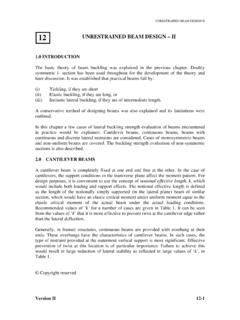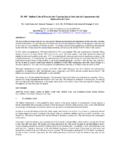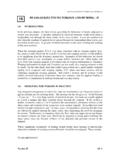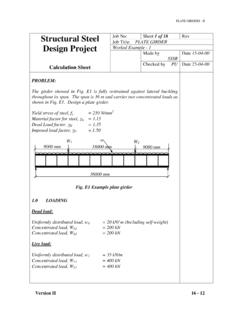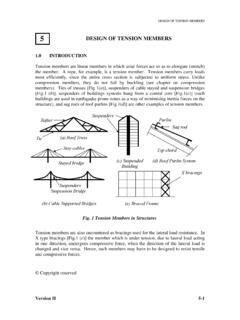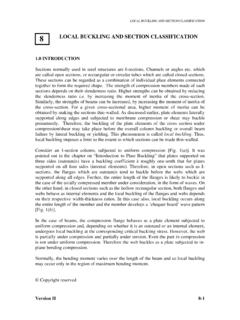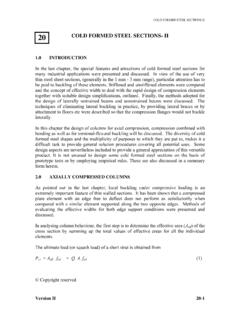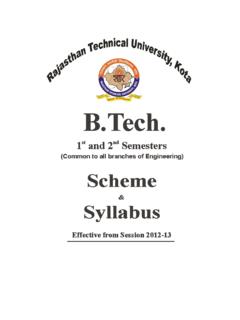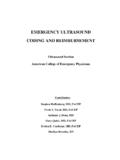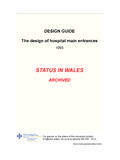Transcription of UNRESTRAINED BEAM DESIGN – I - Steel ..." INSDAG
1 UNRESTRAINED beam DESIGN -I. UNRESTRAINED beam DESIGN I. 11. INTRODUCTION. Generally, a beam resists transverse loads by bending action. In a typical building frame, main beams are employed to span between adjacent columns; secondary beams when used transmit the floor loading on to the main beams. In general, it is necessary to consider only the bending effects in such cases, any torsional loading effects being relatively insignificant. The main forms of response to uni-axial bending of beams are listed in Table 1. Under increasing transverse loads, beams of category 1 [Table1] would attain their full plastic moment capacity.
2 This type of behaviour has been covered in an earlier chapter. Two important assumptions have been made therein to achieve this ideal beam behaviour. They are: The compression flange of the beam is restrained from moving laterally, and Any form of local buckling is prevented. If the laterally UNRESTRAINED length of the compression flange of the beam is relatively long as in category 2 of Table 1, then a phenomenon, known as lateral buckling or lateral torsional buckling of the beam may take place. The beam would fail well before it could attain its full moment capacity.
3 This phenomenon has a close similarity to the Euler buckling of columns, triggering collapse before attaining its squash load (full compressive yield load). Lateral buckling of beams has to be accounted for at all stages of construction, to eliminate the possibility of premature collapse of the structure or component. For example, in the construction of Steel -concrete composite buildings, Steel beams are designed to attain their full moment capacity based on the assumption that the flooring would provide the necessary lateral restraint to the beams.
4 However, during the erection stage of the structure, beams may not receive as much lateral support from the floors as they get after the concrete hardens. Hence, at this stage, they are prone to lateral buckling, which has to be consciously prevented. Beams of category 3 and 4 given in Table 1 fail by local buckling, which should be prevented by adequate DESIGN measures, in order to achieve their capacities. The method of accounting for the effects of local buckling on bending strength was discussed in an earlier chapter. In this chapter, the conceptual behaviour of laterally UNRESTRAINED beams is described in detail.
5 Various factors that influence the lateral buckling behaviour of a beam are explained. The DESIGN procedure for laterally UNRESTRAINED beams is also included. Copyright reserved Version II 11-1. UNRESTRAINED beam DESIGN -I. Table 1 Main failure modes of hot-rolled beams Category Mode Comments 1 Excessive bending W This is the basic failure mode triggering collapse provided (1) the beam is prevented from buckling laterally,(2) the component elements are at least compact, so that they do not buckle locally. Such stocky beams will collapse by plastic hinge formation.
6 2 Lateral torsional Failure occurs by a combination of W. buckling of long lateral deflection and twist. The beams which are proportions of the beam , support not suitably braced conditions and the way the load is in the lateral applied are all factors, which affect direction.( un failure by lateral torsional buckling. restrained beams). 3 Failure by local Unlikely for hot rolled sections, buckling of a which are generally stocky. Box section flange in Fabricated box sections may compression or require flange stiffening to prevent web due to shear premature collapse.
7 Or web under Web stiffening may be required for compression due Plate girder in shear plate girders to prevent shear to concentrated W buckling. loads Load bearing stiffeners are sometimes needed under point loads to resist web buckling. 4 Local failure by W Shear yield can only occur in very (1) shear yield of short spans and suitable web web (2) local stiffeners will have to be designed. crushing of web (3) buckling of Shear yield Local crushing is possible when thin flanges. concentrated loads act on unstiffened thin webs. Suitable stiffeners can be designed.
8 Crushing of web This is a problem only when very wide flanges are employed. Welding of additional flange plates Buckling of thin flanges will reduce the plate b / t ratio and thus flange buckling failure can be avoided. Version II 11-2. UNRESTRAINED beam DESIGN -I. SIMILARITY OF COLUMN BUCKLING AND LATERAL BUCKLING. OF BEAMS. It is well known that slender members under compression are prone to instability. When slender structural elements are loaded in their strong planes, they have a tendency to fail by buckling in their weaker planes. Both axially loaded columns and transversely loaded beams exhibit closely similar failure characteristics due to buckling.
9 Column buckling has been dealt with in detail in an earlier chapter. In this section, lateral buckling of beams is described and its close similarity to column buckling is brought out. Consider a simply supported and laterally unsupported (except at ends) beam of short- span subjected to incremental transverse load at its mid section as shown in (a). The beam will deflect downwards in the direction of the load [Fig. 1(b)]. W W. Undeflected position Deflected position . (a) (b). Fig. 1(a) Short span beam , (b) Vertical deflection of the beam . The direction of the load and the direction of movement of the beam are the same.
10 This is similar to a short column under axial compression. On the other hand, a long-span . beam [ (a)], when incrementally loaded will first deflect downwards, and when the load exceeds a particular value, it will tilt sideways due to instability of the compression flange and rotate about the longitudinal axis [Fig. 2(b)]. Horizontal W . Twisting W W movement Vertical movement . Before After (a) buckling buckling (b). Fig. 2(a) Long span beam , (b) Laterally deflected shape of the beam Version II 11-3. UNRESTRAINED beam DESIGN -I. The three positions of the beam cross-section shown in Fig.
